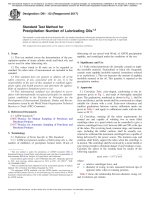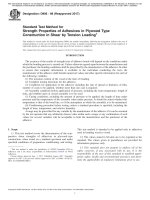Astm d 2423 90 (2017)
Bạn đang xem bản rút gọn của tài liệu. Xem và tải ngay bản đầy đủ của tài liệu tại đây (61.8 KB, 2 trang )
This international standard was developed in accordance with internationally recognized principles on standardization established in the Decision on Principles for the
Development of International Standards, Guides and Recommendations issued by the World Trade Organization Technical Barriers to Trade (TBT) Committee.
Designation: D2423 − 90 (Reapproved 2017)
Standard Test Method for
Surface Wax on Waxed Paper or Paperboard1
This standard is issued under the fixed designation D2423; the number immediately following the designation indicates the year of
original adoption or, in the case of revision, the year of last revision. A number in parentheses indicates the year of last reapproval. A
superscript epsilon (´) indicates an editorial change since the last revision or reapproval.
3.1.2 ream of paper (news and wrapping), n—500 sheets
each 610 mm by 914 mm (24 in. by 36 in.).
3.1.2.1 Discussion—For factors to convert basis weight in
grams per square metre to other commercial reams, see Test
Method D646.
1. Scope
1.1 This test method covers determination of the weight of
wax on the surface of waxed paper.
1.2 The values stated in SI units are to be regarded as
standard. No other units of measurement are included in this
standard.
1.3 This standard does not purport to address all of the
safety concerns, if any, associated with its use. It is the
responsibility of the user of this standard to establish appropriate safety and health practices and determine the applicability of regulatory limitations prior to use.
1.4 This international standard was developed in accordance with internationally recognized principles on standardization established in the Decision on Principles for the
Development of International Standards, Guides and Recommendations issued by the World Trade Organization Technical
Barriers to Trade (TBT) Committee.
4. Summary of Test Method
4.1 The quantity of wax present as a surface film on paper
or paperboard is determined through the difference in weight of
specimens before and after scraping with a razor blade.
5. Significance and Use
5.1 Many of the functional properties of waxed paper and
paperboard are related to the amount of wax present as a
surface film. Test methods which determine wax load by
solvent extraction do not differentiate between the wax present
as a surface wax layer and that which has penetrated into the
substrate. This test method, which mechanically removes the
wax, measures the amount on each surface of the substrate.
2. Referenced Documents
2.1 ASTM Standards:2
D585 Practice for Sampling and Accepting a Single Lot of
Paper, Paperboard, Fiberboard, and Related Product
(Withdrawn 2010)3
D646 Test Method for Mass Per Unit Area of Paper and
Paperboard of Aramid Papers (Basis Weight)
6. Apparatus
6.1 Pad of paper to be used as a cushion under the waxed
paper specimens during the scraping operation.
6.2 Analytical Balance, capable of reproducing weights to
the nearest 0.001 g.
3. Terminology
6.3 Razor Blade, single-edged for scraping the wax from the
specimen.
3.1 Definitions:
3.1.1 basis weight of paper, n—basis weight is expressed in
grams per square metre. In countries where the metric system
is not universal, basis weight is also expressed in pounds per
ream.
6.4 Trimming Board, or other device for cutting paper
specimens. A paper cutter having an attachment for ensuring
parallelism of the opposite edge of the trimmed sheet, or a
template, or a die cutter is recommended.
6.5 Measuring Device, capable of measuring the size of the
specimen to an accuracy 0.5 mm.
1
This test method is under the jurisdiction of ASTM Committee D02 on
Petroleum Products, Liquid Fuels, and Lubricants and is the direct responsibility of
Subcommittee D02.10.0A on Physical/Chemical Properties.
Current edition approved June 1, 2017. Published July 2017. Originally approved
in 1965. Last previous edition approved in 2012 as D2423 – 90(2012)ɛ1. DOI:
10.1520/D2423-90R17.
2
For referenced ASTM standards, visit the ASTM website, www.astm.org, or
contact ASTM Customer Service at For Annual Book of ASTM
Standards volume information, refer to the standard’s Document Summary page on
the ASTM website.
3
The last approved version of this historical standard is referenced on
www.astm.org.
7. Sampling
7.1 Select samples that are free of wrinkles, cuts, or other
defects in accordance with Practice D585.
8. Procedure
8.1 Prepare a specimen consisting of a 100 mm by 100 mm
square of waxed paper. Determine the area (in square millimetres) of each specimen to the nearest 1.0 % of its total area.
Copyright © ASTM International, 100 Barr Harbor Drive, PO Box C700, West Conshohocken, PA 19428-2959. United States
1
D2423 − 90 (2017)
ream, see Test Method D646. To obtain results in terms of
pounds per 1000 ft2, multiply the grams per square metre by
0.205.
8.2 Weigh the specimen on the analytical balance to the
nearest 0.5 % of its total weight.
8.3 Remove the surface wax from one side of the specimen
(side No. 1) by scraping toward each of its four edges as
follows: Hold the specimen firmly on the pad to prevent
slippage. With a razor blade held vertically, scrape the entire
area of one side of the specimen with repeated one-directional
strokes of the blade, slightly overlapping the strokes. Rotate the
specimen through 90° and repeat the scraping. Continue
rotating and scraping twice more to complete the process.
11. Precision and Bias
NOTE 1—The precision data were obtained on five replicate specimens
(in each laboratory) on samples of commercially waxed paper with a
weight range of between 3.25 g ⁄m2 and 9.76 g ⁄m2 (2 lb ⁄3000 ft2 and
6 lb ⁄3000 ft2) of wax on each surface.
11.1 Precision—The precision of this test method as determined by statistical examination of interlaboratory results is as
follows:
11.1.1 Repeatability—The difference between two test
results, obtained by the same operator with the same apparatus
under constant operating conditions on identical test material,
would in the long run, in the normal and correct operation of
the test method, exceed the following values only in one case
in twenty:
8.4 Reweigh the specimen as described in 8.2. Record the
weight of the specimen as the scraped basis weight side No. 1.
8.5 Remove the surface wax from side No. 2 of the
specimen by scraping as described in 8.3.
8.6 Reweigh the specimen and record the weight as the
scraped basis weight side No. 2.
0.976 g/m 2 ~ 0.6 lb/ream!
9. Calculation
(1)
11.1.2 Reproducibility—The difference between two single
and independent results obtained by different operators working in different laboratories on identical test material would, in
the long run, in the normal and correct operation of the test
method, exceed the following values only in one case in
twenty:
9.1 The surface wax weight is determined by weight difference. The weight of surface wax on side No. 1 of the sample is
the difference between the initial weight and the scraped
weight side No. 1. The weight of the surface wax on side No.
2 of the sample is the difference between the scraped weight
side No. 2 and the scraped weight side No. 1. Multiply the
weight in grams per square millimetre by 106 to convert to
grams per square metre.
1.46 g/m 2 ~ 0.9 lb/ream!
(2)
11.2 Bias—The procedure in this test method has no bias
because the surface wax on waxed paper or paperboard can be
defined only in terms of a test method.
10. Report
12. Keywords
10.1 Report the surface wax weight in grams per square
metre. To convert from grams per square metre to pounds per
12.1 paper; paperboard; wax
ASTM International takes no position respecting the validity of any patent rights asserted in connection with any item mentioned
in this standard. Users of this standard are expressly advised that determination of the validity of any such patent rights, and the risk
of infringement of such rights, are entirely their own responsibility.
This standard is subject to revision at any time by the responsible technical committee and must be reviewed every five years and
if not revised, either reapproved or withdrawn. Your comments are invited either for revision of this standard or for additional standards
and should be addressed to ASTM International Headquarters. Your comments will receive careful consideration at a meeting of the
responsible technical committee, which you may attend. If you feel that your comments have not received a fair hearing you should
make your views known to the ASTM Committee on Standards, at the address shown below.
This standard is copyrighted by ASTM International, 100 Barr Harbor Drive, PO Box C700, West Conshohocken, PA 19428-2959,
United States. Individual reprints (single or multiple copies) of this standard may be obtained by contacting ASTM at the above
address or at 610-832-9585 (phone), 610-832-9555 (fax), or (e-mail); or through the ASTM website
(www.astm.org). Permission rights to photocopy the standard may also be secured from the Copyright Clearance Center, 222
Rosewood Drive, Danvers, MA 01923, Tel: (978) 646-2600; />
2









